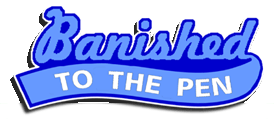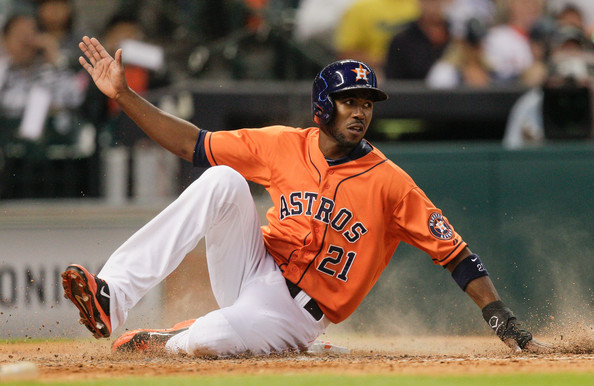The Chicago Cubs traded third baseman Luis Valbuena and right-handed pitcher Dan Straily to the Houston Astros Monday, for outfielder Dexter Fowler. It’s a win-now move on both sides, as Valbuena will move offensively helpless Matt Dominguez into the short side of a platoon, and Fowler goes right to the top of the Cubs’ batting order—whether that be as the everyday center fielder, the regular left fielder or some blend of the two.
***
Every team goes into the MLB offseason with a checklist. It must be a malleable, fluid one, because so many variables determine whether a given move is right, and because some other team might simply beat you to the punch, sometimes. Still, there must be clear objectives, because without them, there’s little chance you come out of the transaction period with a coherent plan in place for the next season.
If one were to list the Chicago Cubs’ priorities heading into this critical winter, as they sought to make the transition from rebuilding to contending, it would read thusly:
- Repopulate the starting rotation. For the third straight season, the Cubs traded away two starting pitchers during the summer. That left a rotation with breakout stud Jake Arrieta first, but rookie control artist Kyle Hendricks second, and then a whole lot of question marks. Conventional wisdom held that the Cubs needed to add at least one starting pitcher, and preferably two, in order to amass competitive rotation depth.
- Do something about the catcher position. Welington Castillo is an acceptable hitter, for a catcher, and there’s a little bit of offensive upside there, too, but he became intolerably bad behind the plate in 2014. He’s an abhorrent framer, which is any catcher’s most important defensive skill set. He’s inconsistent in his blocking and fielding of balls around the plate, and he runs like he’s wearing a weighted bodysuit. He also visited the DL for the fourth consecutive season, revealing (for the fourth consecutive season) the Cubs’ dearth of catching depth. The team needed a better, and a more reliable, option.
- Find on-base percentage, preferably in the form of a leadoff hitter. The Cubs have finished 28th, 28th and 27th in OBP over the last three seasons. An average offense—and only six of the 30 playoff teams over that span have been average or worse—is nearly impossible to achieve with so many out machines in the lineup. If they wanted to get serious in 2015, Chicago needed a stronger top of the order, and a stronger OBP as a team.
There were secondary objectives, to be sure—the front office would need to strengthen a miserable bench and reinforce the bullpen against some expected regression—but the team took a competitive stance to open the Hot Stove season, and if they were serious about that, they would need to address their major areas of weakness with some grand gestures.
The club made at least one attempt to kill two birds with one stone, but they were outbid for the services of free-agent catcher Russell Martin (and his .402 OBP). Thereafter, though, they started knocking down pins efficiently and forcefully. Jason Hammel came back on a two-year deal, filling out the middle of the rotation. Miguel Montero cost very little in trade, and balanced the lineup while bringing improved defense and on-base skills behind the dish. Jon Lester, of course, got the big deal and the bold-faced headlines. Just like that, the first two items on the list were taken care of.
Since then, the team had addressed those secondary concerns. David Ross and Chris Denorfia joined November acquisition Tommy La Stella on a rebuilt bench. Jason Motte joined the bullpen, which will run deep once one or two would-be starters miss the rotational cut and join the ranks. Still, the third major mandate of the winter had not been met, and it was beginning to feel like the most crucial.
Enter Fowler.
Cubs Projected Lineup, Before and After Fowler Trade
| Before Deal | Opening Day | May 5 |
| Chris Coghlan – LF | Dexter Fowler – CF | Fowler – CF |
| Luis Valbuena – 3B | Coghlan – LF | Castro – SS |
| Starlin Castro – SS | Castro – SS | Rizzo – 1B |
| Anthony Rizzo – 1B | Rizzo – 1B | Kris Bryant – 3B |
| Jorge Soler – RF | Soler – RF | Montero – C |
| Miguel Montero – C | Montero – C | Soler – RF |
| Javier Baez – 2B | Baez – 2B | Coghlan – LF |
| Arismendy Alcantara – CF | Mike Olt – 3B | Baez – 2B |
Fowler’s career .366 OBP may be somewhat propped up by having spent so much time in Coors Field, but it’s still a very strong number. A league-average hitter would have posted a .344 figure in the same environments. Valbuena has a .310 career OBP (.331 would be average across his environments), and a .337 mark since the start of 2013 (.325 would have been average). Meanwhile, Castillo (.324 career, against a .326 contextual average) has been swapped out for Montero (.342 career, .334 expected average). This team will get on base much more than the one that finished 2014.
While the move temporarily weakens the team at third base, it makes them much stronger once Kris Bryant arrives. Valbuena would have lost his full-time gig when Bryant arrived, anyway. With Fowler taking over center field, Alcantara is also free to get playing time at a number of positions, giving rest and working matchups as Joe Maddon sees fit. (Oh, Chicago also added the best manager in baseball to its organization this winter.)
This isn’t unprecedented, I’m sure. Teams have made bigger splashes in past winters. Two or three teams could even claim to have made bigger splashes this winter. Given what Chicago needed, though, and where they sit competitively, and what they had to work with, this offseason looks inspired. The Cubs remain behind the Cardinals in any reasonable projection of the NL Central, but they might have vaulted the Pirates, and in any case, they’re legitimate contenders for the first time since they last fielded a competent offense: 2009.
***
On the Astros side, this is a similar move. They had the opposite of the Cubs’ positional profile, deep at catcher and in the outfield, thin on the infield, especially the left side. Pairing their earlier signing of Jed Lowrie and the acquisition of Valbuena, they have addressed their points of weakness, and they continue to load up on high-ceiling power hitters for their outfield and DH spots. One of Houston’s biggest priorities this winter, as difficult as it might be, was to improve the league’s worst bullpen. They did so, with the twin signings of Luke Gregerson and Pat Neshek. The starting rotation remains deep but problematically flat. There are questions about the team’s offensive viability, even after these moves. The Astros have restructured their roster, though, in a way that permits them to at least entertain the idea of challenging the Athletics, Angels and Mariners in a loaded AL West.
It also helps the team balance its lineup better. Fowler is a switch-hitter anyway, but assuming he was going somewhere anyway, getting Valbuena helps the Astros avert the problem of being too right-handed offensively. Chris Carter, Evan Gattis, George Springer, Jose Altuve and Jake Marisnick all bat right-handed. Valbuena joins Jonathan Singleton, Jason Castro and the switch-hitting Lowrie as lefties capable of mashing right-handed pitchers who might get the better of the big bats in the order.
One more thing: the Astros get two years of Valbuena and a few more of Straily in the deal. Fowler will be a free agent at the end of the season. On balance, given the Cubs’ needs, the move helps, and they’re closer to reaching the playoffs in 2015, anyway. In the long run, though, Houston did very well for themselves in this deal, sacrificing not an iota of their competitive chances for this season but securing some value beyond that, as well, knowing that they still have some giant-killing to do if they hope to compete in the AL West.
Next post: BttP Podcast: Ep 3 – Alex Crisafulli & Ken MaedaPrevious post: Washington Signs Max Scherzer to Sure Up the NL East





Myles
Great article.
Matthew Trueblood
Thanks, Myles!